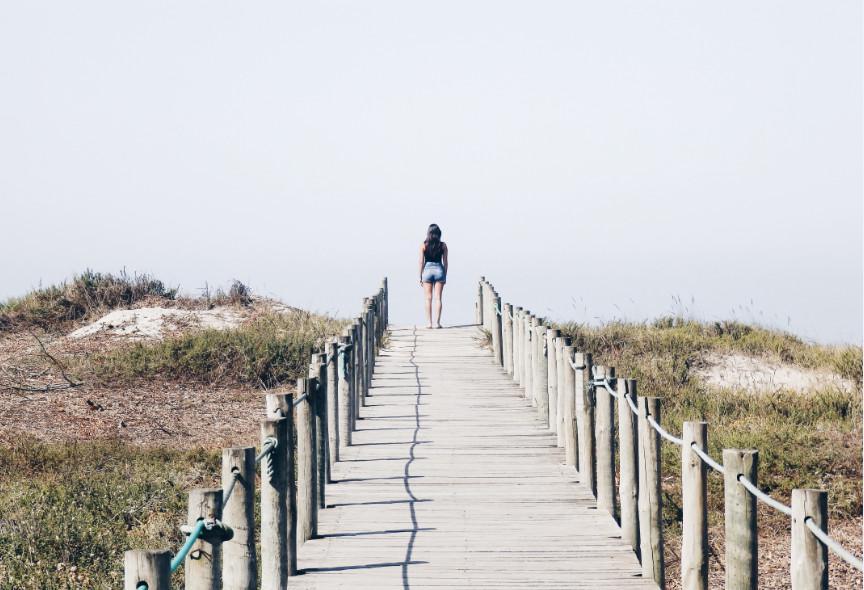
22 Sep Boot Camp for the Heart: Brigid Delaney Treads the Path of Love, a Journey Inwards
Is she psychologically strong enough to endure the mysterious Path of Love retreat? With emotional baggage in hand, Brigid Delaney checks in to find out.
One night out with my former boss, he posed a question – would you rather have: a) a trip to the moon; b) free travel around the world; c) a chance to do as much Jungian therapy as you wanted.
He and I chose C. There is definitely something more intrepid – and scary – about going inwards. But I’d never really put it to the test, until now.
When I signed up to the Path of Love course, I wasn’t told much about what the seven days in the NSW Hunter Valley would involve, just that I’d be encouraged to hand in my phone and, while there, to refrain from alcohol and stimulants such as coffee.
Fine. But what was actually going to happen? The website’s many fulsome testimonials about how the Path of Love had changed their lives were vague on what actually went on. The colleague who recommended I attend and a Path of Love organiser were also mysterious and coy about what would go down.
“You’ve done a lot of travel journalism,” said my colleague. “Think of it as an incredible, wild, sometimes scary but hugely rewarding journey that you are about to undertake – but the journey is not to another country, it’s into yourself.”
Did I want to go there? Not really. Maybe I should have wished for a trip to the moon. But I was curious.
So I signed up.
First, what is the Path of Love? It’s a global phenomenon with retreats in the US, Europe, the Middle East and Australia. The vibe is a mix of Eastern spirituality and Western psychotherapy, drawing on the works of Sufi mystics, Jung, Osho, the teachings of Buddha and Jesus, the cartoons of Leunig and the writings of Irish poet and philosopher John O’Donohue.
Established in 1996 and running in Australia for 20 years, the Path of Love can loosely be described as a self-development course. In Australia, it’s run by Alima Cameron and Samved Dass, who both have worked in counselling and psychotherapy for more than 30 years.
People come to it by word of mouth, often when facing a crisis – stress, a bereavement, unhappiness or anxiety.
“People come with their issues,” says Alima. “Things that cause suffering and separation, but they’re all welcome.”
But some people simply come out of curiosity or a desire to explore aspects of themselves that over time have been cut off or repressed.
“They are seeking a wider view on what life is,” says Samved.
One of the aims of the program is to get you moving towards a place where love is at the centre of all your relationships (particularly your relationship with yourself).
“It’s a journey out of separation, feeling alien, separate from others, to connection,” says Alima. Modern life can make us atomised and alone. This is about fostering connection.
The name – Path of Love – suggests a relatively pleasant, hippie-style retreat with candles and lots of “Oms”. It’s not. I’ve done retreats before, mostly of the yoga and meditation variety, and this was very different. It was one of the most gruelling weeks of my life. Think of it as a boot camp for your emotional life (or as one journalist from Britain’s Sunday Times put it, the equivalent of “two years of therapy in one week”).
The facilitators call it a “process” and for a week – putting in very long days and nights – I was not sure what to expect from one hour to the next.
“I won’t change,” I promise my worried friends. Yet when I finish the week, utterly exhausted, I realise I have changed. And it’s all for the best.
So what happens?
I arrive at the retreat centre. There are about 30 participants, most of whom are Australian. We range in age from our 30s through to our 60s, although Samved tells me that people from their 20s right through to their 80s have completed the Path of Love.
Before they are accepted into the course, participants are screened via an interview and a fairly exhaustive and probing questionnaire. “People need to have a certain ability to move and need to be psychologically stable enough to do the work,” says Samved. “People need to have a degree of functionality.”
The work is difficult, psychologically and physically, and you need to be strong to get through it, although there is a lot of support. The program is very well run and there is a large staff, almost one-on-one much of the time.
At the start of the program you are encouraged to leave your everyday life at the door. Samved and Alima meet us and congratulate us on taking the brave decision to do the course, and then take us through some of the central tenets that we will be asked to keep returning to over the course of the week. These are things such as “I am willing to face where I am afraid” and being willing to really look at what is missing in our lives. We are then led into a hall where we are divided into groups of about 10.
I didn’t realise it at the time, but by the end of the week, the people in my group will know more about me than my closest friends. We’ll have laid ourselves bare, exposing the horrors, beauty and vulnerabilities we all have. And within the group, and ourselves, we’ll have found acceptance.
But I don’t know that at the start. Instead, I have to stand up and tell the group why I am here and that I am committed to change.
I don’t really want to expose myself to a bunch of strangers. There are dissatisfactions and disappointments in my life that I can barely admit to myself, let alone people I have just met. I squirm, mutter and mumble and look to the facilitators for help. Each group has two, to provide support and ask probing questions. But I am not off the hook – the bravery required to share and the insights that you get from the process are things you must come to on your own.
In the next round of “sharing”, we stand up while the other members of the group each say what they really think of us. This relates to the mask we all wear. “We all have our conditioned personality – which is set up by all the pain from our childhood,” says Samved. “We put on our personality mask and that is obscuring our ability to be natural and relaxed.”
Man, this is the worst. My level of discomfort is so deep I can’t even take in what some people were saying about me. But some of it really hits the mark. Yes, I live life with my head, not my heart. And yes, I am my own worst critic. How did these people know this after such a short time?
Day one and already I am feeling big emotions – mostly fear. But that is what the course promises, to take us from our heads to our hearts, and the best way of doing this is to think less and feel more.
During the week I get a lot of insights around this. Unconsciously we (by that I mean me) blunt our feelings through drinking or drug-taking, distractions such as the internet or television or social media. We dull them through prescription drugs that promise to take away sadness and anxiety. We don’t realise it, but much of the time we walk around numb.
Our minds work hard to label our experiences as good, bad, fun, boring etc, so a lot of what we experience is filtered through a fairly judgmental lens.
To move into a state where feelings have primacy over thinking, and to wake up feelings that are pretty dusty, the Path of Love has a number of elements that are quite physical, sensual even (not to be confused with sexual).
Touch plays a big part.
Each morning starts at 6am with a meditation I dread. Called Dynamic, it goes for an hour, is shouty, involves lots of jumping and making noises.
Although we are in silence when we are not in sessions, the Path of Love is noisy. And the noises – at least at the start – make me very uncomfortable.
People cry – a lot. Even when we are sitting quietly before sessions, there is the sound of people sobbing around me. The automatic response is to comfort them or talk to them, so initially it feels weird just to leave people to it. But I later realise many participants feel relieved that they are in a place where they can just totally let go and let the tears flow. By the end of the week,
I recognise where people are in the room not by the sound of their speaking voice, but by the sound of their tears.
We also move a lot. I had a Fitbit with me and I was doing 24,000 steps a day. This is mostly dancing. When people aren’t sitting or lying around sobbing, they are dancing like maniacs at a rave. I wake up each morning sore from dancing.
At the start I feel uncomfortable all the time – with the noises, the morning meditations, the dancing, but mostly with the release. Standing up in front of the group I am paralysed with embarrassment. When, on day three, we are told that “today is Shadow and Shame day” – and we must bring to the group the thing we have gone to the greatest lengths to conceal, I consider leaving. I am embarrassed and afraid – for myself and others. (Samved later tells me this is why people aren’t told this happens before they go in – they are liable to freak out.)
Then I realise this is one of the points of the whole thing: releasing emotions, old hurts, betrayals, ugly feelings in a space that is completely safe, where you won’t be judged. After all, if you walked down the street wailing and crying and screaming and beating things up with a rubber bat (we do that, too), you would likely be committed.
Here, it’s okay. It’s more than okay. Shame and Shadow Day is not as traumatic as I imagine. It is actually liberating to let it all out. (In the end, the hardest part is picking which bit of shame to tell my group about.) Sharing stories in my small group is a revelation. People have the most extraordinary lives, and I hear incredible things and witness people moving from hurt and anger to a much happier place.
But what about me? Once I decide to let my inhibitions go, I start to enjoy myself. I even have fun. The insights I have about my patterns and my life come so fast that I fill an entire journal.
It’s now been three months since I did the Path of Love and I need to keep reminding myself of the things I learnt. I need to keep working on dropping from my head to my heart.
I need to keep reminding myself how much humanity we all share – and how quickly and deeply we can connect with others and ourselves.
The journey has just begun. •
Sourced from: Daily Life http://www.dailylife.com.au
Photo: Stocksy






